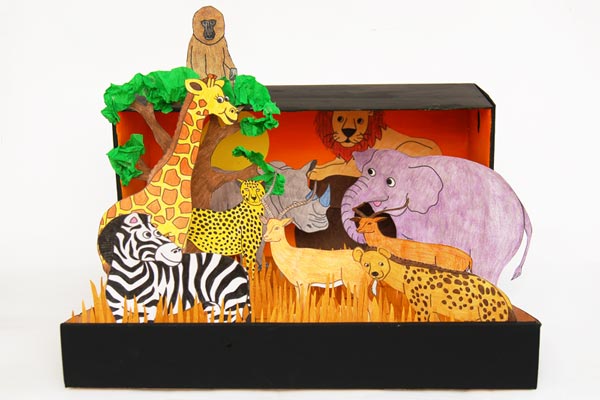Dinosaur Diorama
Featured Crafts
Supplies Needed
- Shoebox
- A4 or Letter size cardstock (for paper dinosaurs) or plastic toy dinosaurs
- Crayons or colored pencils
- Tempera or poster paint
- Paint brush
- Crepe paper (green, brown, blue)
- Craft sticks
- White glue
- Glue gun
- Scissors
- Cardboard or paper plate
- Small paper bowl or egg carton
- Small rocks
- Aluminum foil
- Blue paper or blue aluminum foil
- Newspapers
- Craft foam flowers, paper flowers, or flower sequins (optional)
- Pipe cleaner or craft wire (optional)
- Cotton (optional)
STEPS
2Plan your diorama.
Think about the prehistoric period you want to portray and plan what details you'd like to include like the dinosaurs, plants, bodies of water, volcanoes, etc.
Ours is a Cretaceous period diorama, which is known for its lush rainforest environment and iconic dinosaurs such as the Tyrannosaurus rex, triceratops and spinosaurus.
3Paint the box.
Paint a background inside the shoebox using tempera or poster paint. Paint it blue to create a sky or green for a rainforest background. You can also paint the outside of the box. If it has a glossy finish, use acrylic paint.
Instead of painting, another option for the background is to cover the inside walls of the box with blue or green colored paper.
5Create rocks.
Use real rocks or make them out of various materials:
a.) Paper plate rocks - make rocks for the background by cutting a paper plate or thick cardboard into sections. You can either paint them or cover them with black or brown crepe paper. Slightly crumple up the crepe paper before gluing them to give the rocks a textured surface.
Glue the paper plate rocks onto the walls of your box diorama.
b.) Paper rocks - an easier option for rocks or boulders on the background is to cut rock shapes out of paper. Choose textured paper like sand paper or textured cardstock, or better yet, choose a variety of paper types so that you still achieve lots of texture and contrast.
6Make a tree.
Make a paper tree following Steps 6 to 8 of our African Savanna Diorama.
7Add a body of water.
Make a lake, stream, or any body of water using blue paper, crepe paper or colored aluminum foil. Cut your chosen material into the desired shape and size and glue onto your diorama's ground.
We used aluminum foil and colored it blue ourselves—see how in our Colored Aluminum Foil page. Slightly crumple up the blue aluminum foil then spread it out flat before gluing onto the box.
8Build the ground.
Some options for making a ground for your diorama are described below.
a.) Paper - the easiest option is to cut and glue green or brown construction paper to cover the entire floor of your box diorama. This is best done after Step 3.
b.) Air dry clay - for a three-dimensional ground, air dry clay is a convenient option. You can also make salt dough, which is a homemade version. Cover the entire floor of your diorama with the clay or dough. Pat the clay around objects like rocks or trees.
c.) Papier mache - if you want to try something different, you can make a papier mache ground like we did. Tear newspapers or any paper for recycling, into strips. Crumple up each strip and glue onto the bottom of the box using white glue. This layer of newspaper creates the base over which to build the papier mache.
9Make ferns and plants.
Read up on the prehistoric period you're portraying and make the plants based on what you've learned. Our Diorama Plants and Trees page has lots of ideas and tips for creating all kinds of plants for a diorama.
11Finish the papier mache ground.
Cut or tear brown crepe paper into 1-inch wide strips. Prepare your papier mache paste and use a paint brush to apply paste onto a section of the newspaper ground. Lay a few strips of crepe paper over the paste. Brush the crepe paper strips over with more paste and gently pat down so that the wet crepe paper sticks to the newspaper.
12Create paper dinosaurs.
Draw your own dinosaurs or print out any of the dinosaur sets below. Color and cut out the dinosaurs.
Instead of paper dinosaurs, you can also use plastic toy dinosaurs to populate your diorama.
13Position the dinosaurs using tabs.
Paper tabs allow you to attach the paper dinosaurs to the diorama's wall or ground.
a.) Center tabs - these let you attach a dinosuar onto the background wall. Fold a short strip of construction paper on both ends. Glue one end onto the back of the dinosaur and the other end onto the wall. A large dinosaur will need a pair of center tabs while smaller ones will just need one.
15Enjoy your diorama.
After positioning all the dinosaurs, you can now sit back and enjoy your incredible prehistoric diorama. Check out more habitat diorama projects:
More Ideas
Use more three-dimensional objects.
In this Triassic-inspired diorama, we used more three-dimensional items such as dinosaur plastic toys, real rocks, and three-dimensional paper trees. Learn how to make these easy paper trees at our Diorama Plants and Trees page.



























